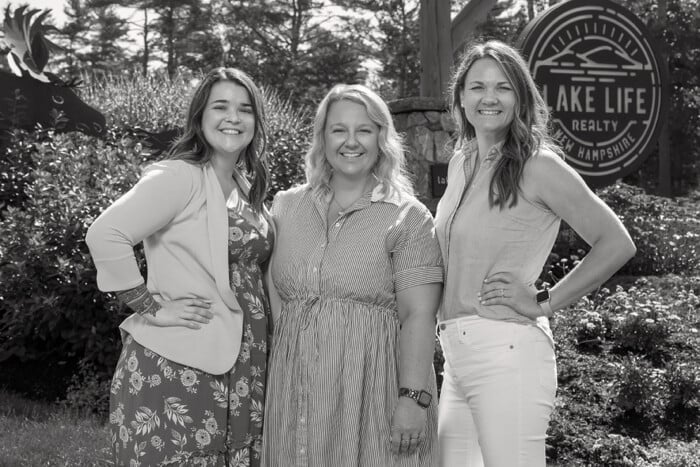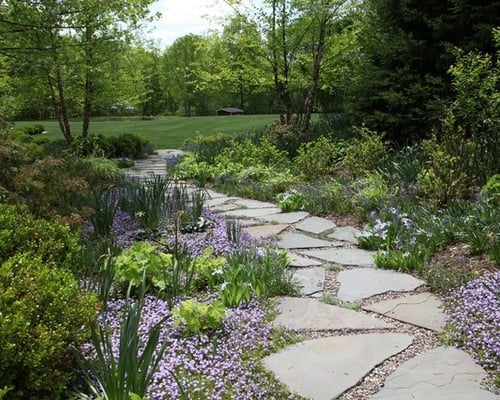A Garden for the Ages
Family roots run deep at Boggy Meadow Farm.

This Victorian-era statue, surrounded by evergreen pachysandra, is one of many from Fanny Mason’s day that were found on the property.
Boggy Meadow Farm in Walpole once consisted of 1,000 acres of fields, forests and hills overlooking the nearby Connecticut River. In the same family and continuously farmed since 1790, the remaining 600 acres are now home to Stephanie Cabot and Marcus Lovell-Smith, who carry on the legacy.
Cabot and Lovell-Smith took over the management of the 500-cow dairy when they moved back from England in the early 2000s. The fields and barns are now leased to another local dairy farmer, but the couple continues to run the farmstead cheese operation started by Cabot’s father to supplement low milk prices after taking the farm over from his cousins. Now they produce three artisan cheeses — Baby Swiss, Smoked Baby Swiss and Fiddlehead Tomme — that can be found in local stores including some Hannafords and Whole Foods.
“Our goal is to continue to be a working farm,” says Cabot, “and hopefully our children will keep it going.” Lovell-Smith has taken his experience on the dairy farm to a new level by founding the first carbon-neutral food company in the U.S. Called Neutral, it works with farmers across the country to help them mitigate emissions and sequester carbon on their farms.
Family Legacies

Cabot says their 1838 Greek Revival house, built by the Mason family as a summer escape from the city, is in a constant state of restoration. The walkway to the side porch is lined with herbs, and boxed-in raised beds on the front lawn hold lettuce, tomatoes, peppers and kale for quick summer salads.
Their home, an 1838 Greek Revival mansion, sits high on a windy bluff with views of the low-lying meadows for which the farm was named. It is surrounded by lush informal plantings but also contains features from older, more formal gardens that once graced the landscape and were created more than a century ago by Fanny Mason, a cousin of Cabot’s great-great grandfather.
Mason’s father, a prominent Boston banker and businessman, owned Boggy Meadow Farm at that time, and the mansion was their summer home. He sold off bits and pieces of land to neighboring farmers over the years, but after his death in 1901 Fanny bought back most of that land along with other adjoining parcels to restore Boggy Meadow to its original size. Even though she also had homes in Massachusetts, she was a generous benefactor to the town of Walpole, funding the district nurse and serving on various boards. “We also think she paid for the architects who designed the town hall,” says Cabot. “She was admired by a lot of people.”
Mason was a founding member of the town’s historical society and left part of her estate to Walpole for a town forest that today bears her name. According to the Walpole Conservation Commission, the 286-acre tract, located on both sides of Route 12, is the crown jewel of their multiple-use forests. A patron of the arts, she was a noted contributor to the music program at Harvard, and the music building there is named for her. The Peabody Mason concerts that began in the family music room in 1891 continue today, although at larger venues such as Boston’s Symphony Hall. She also left a fund honoring her longtime friend, artist Alice Thevin, to the Museum of Fine Arts in Boston for the acquisition of artwork.
Reviving the Landscape

Golden-leaved chamaecyparis and green-and-white hakonechloa grass brighten a shady border backed by tall rhododendrons.
Mason welcomed the family’s society friends along with talented musicians and writers to Boggy Meadow each summer, hosting lively soirées. Her extensive gardens were part of the draw and even cited in the Walpole Town History. Features including a long, vine-covered grape arbor leading from the house to a stone-walled sunken garden, a dome-topped folly and a ravine garden still remain, and Cabot and Lovell-Smith are bringing them back to their original grandeur. Cabot’s father, an avid plantsman, first undertook the restoration of the gardens while he lived there. “My father had a passion for plants and worked on the borders, but the gardens were abandoned near the end of his life,” she says.

Helen O’Donnell worked with the homeowners to revive a 100-plus-year-old landscape, adding more color with new island gardens and borders. “When I started, there weren’t many flower gardens,” she says.
Gardener Helen O’Donnell of The Bunker Farm in Dummerston, Vermont, has been instrumental in breathing new life into the gardens. “This was my first big installation and maintenance job, and we have kept it going year after year,” she says. Known for the unique varieties of annuals and perennials she grows from seed in her greenhouse and raises in her nursery, her garden design business is now in high demand. “Most of the good ideas start with Stephanie,” she states, modestly. “She’s the visionary, and I put the plant cocktail together. All the structural elements are here. They unearthed the foundational components and we started with the sunken garden.”
Sunken Garden
The white-columned arbor supporting ancient grape vines forms a 100-foot-long covered walkway leading from the side lawn to Mason’s sunken rose garden. Alongside the roses, primroses, peonies, hydrangea, delphiniums and Solomon’s seal bloom against the stone retaining wall enclosing it, and white petunias cascade over its edge. “It is less structured and more exuberant than in Fanny’s day,” says Cabot. Yellow corydalis pops up here and there. “We started with nine plants,” says O’Donnell, “but it likes it here and now it’s everywhere!”

The stately fountain is the centerpiece of the sunken garden; water overflows into a small koi pond beneath and is recirculated to the top.
Thyme carpets the ground between the paving stones, and the classic scallop shell fountain mounted on the back wall still works. The romantic color palette also includes cleome, anemones, foxglove, lilies, gladiolus and aconite growing in the border atop the wall. A tall yew hedge behind the border blocks the view of neighboring buildings, making the garden an intimate space for entertaining or quiet contemplation. “We hold a winter solstice event here,” says Cabot, “and in summer, we set up long tables under the arbor for dinners.”

A rustic gazebo built by Cabot’s grandfather, and later restored by her father and uncle, is a shady getaway surrounded by ferns and hostas under a giant locust tree.
Tucked away under the shelter of tall locust trees on a nearby knoll is a rustic, six-sided gazebo built by Cabot’s grandfather. “I like thinking about how Fanny Mason planted all these locust trees over 100 years ago and now they are huge,” says O’Donnell.
Rose Garden
Cabot and Lovell-Smith unearthed brick walkways in the side yard that must have belonged to an old garden. “They put in boxwood hedges to make an herb garden there, but later on Stephanie wanted to add roses and they have become the main feature,” says O’Donnell. “They get more sun here than in the sunken garden,” she points out. The four quadrants each have a different hardy shrub rose — light pink ‘Fairy,’ bright pink ‘Gertrude Jekyll,’ yellow ‘Charlotte’ and dark pink ‘John Cabot,’ named for the explorer, a distant relative.
“We also added verbena bonariensis, cleome, clematis and alliums to each square,” O’Donnell says. In the center, a white wisteria grows on a tall iron support made from an old well head Cabot and Lovell-Smith found on another part of the property. Herbs now grow along a walkway leading to the house where they are more easily accessible when cooking.
The Girl in the Dell

In the dell garden a vintage statue backed by an arch-topped trellis is uplit at night, adding a mysterious glow to the landscape that beckons you to venture down the hill.
On the opposite side of the house, Cabot and Lovell-Smith found overgrown stone steps leading down a steep slope into a ravine near the base of the bluff. “There was obviously a lawn here at some point, and my parents had put a bench down here,” says Cabot. Vinca now lines the path, punctuated with upright cedars leading to a statue of a young woman holding a book. “Marcus found it for our anniversary. The book is a wink to my career in publishing,” says Cabot. “It is new to the property but about the same vintage as the house.” Inspired by other statuary found on the grounds, it is backed by a tall wooden Palladian trellis, one of several that formerly hung on the folly.
The Folly

The folly is used year-round for family gatherings. Cabot is letting the lawn around the folly grow up to form a pollinator-friendly meadow as part of their rewilding plan.
As garden buildings go, the classic bright white, octagonal folly with a domed roof is a stunning accent. Inside, it has a mosaic tile floor bordered by a Grecian wave pattern and pastel murals of Yosemite by American impressionist Howard Gardiner Cushing on the walls. Too elegant for a child’s playhouse, it seems like an outdoor living room poised and ready for a party. Mason and her guests used it as a summerhouse to shelter from heat and bugs while enjoying the views over the meadows, and she often held concerts here as the acoustics are excellent for singers and instrumental quartets. Cabot’s family uses it for parties and winter dinners, especially during the holidays. “This whole place was meant for entertaining,” she says. “The house is open to a big tribe of cousins, and we host a lot of parties and fundraisers. We can seat 66 people in the barn for New Year’s Eve and still have plenty of room for dancing.”
Homage to the Past
Cabot has trunks full of memorabilia, including old photos of Boggy Meadow, many from Fanny Mason’s day, to guide them. “It has been incredibly gratifying and fun to rebuild even a small part of what Aunt Fanny had a team of 10 gardeners do,” says Cabot. “Helen has been amazing to work with, and we couldn’t have done it without her.” While honoring the aesthetics of a bygone era, they also are doing some rewilding by bringing back the river birches that once grew here and planting more trees on the lawn. Preserving the past with an eye to the future while making a home for their family to enjoy is a balancing act. “I like the mixture!” Cabot says.
Resources
The Bunker Farm • (802) 387-0223
E.C. Brown’s Nursery • (802) 785-2167
Inspired Gardener • (603) 399-4354
The Garden Conservancy
Love of gardens is in the Cabot DNA. Frank Cabot, a distant relative of Stephanie’s is the founder of The Garden Conservancy. It is said that when the gardener dies, the garden does too, but The Garden Conservancy, which began in 1989 as a way to preserve one notable garden, has gone on to help in the preservation of hundreds more. Some have become public gardens such as Ruth Bancroft’s Dry Garden in Walnut Creek, California; Greenwood Gardens in Short Hills, New Jersey; The McLaughlin Garden in South Paris, Maine; and Frank Cabot’s own estate, Stonecrop Gardens in Cold Springs, New York. Each summer, hundreds of private gardens across the country are open to the public during The Garden Conservancy’s Open Days Program. Check out the schedule at gardenconservancy.org/open-days in the spring and make plans to visit some.











